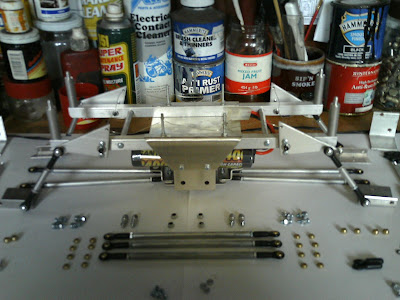
I've placed a pair of batteries into the chassis in order to assess their best location. The prime consideration here is to keep their combined center of gravity as low and as central as possible:

The outsides of the batteries contact the side link chassis mounts, and will require padding here. I've turned these screws around so that the fastener heads are situated inboard. These holes appear to double as tooling holes used in the pressing and punching of the lower chassis section, being as the are quite considerably oversize for their final use. The ESP instructions advise using a conical washer turned cone-to-plate to centralise these fixings in their locations. The anti-swaybar mounting sideplates co-located at this position, and previously acted as a doubler plate here, but because I'm not using them (yet?) I'm down to a single plate. I've actually tried using two cone washers here, one on each side of the plate, although the cones just contact centrally before the joint is actually closed. I'm going to give it a bit more thought here before I finalise the detail here, this area is relatively highly stressed and therefore prone to wear, especially the holes in the aluminium sideplates themselves.

The cantilever rod top mounts have been assembled as instructed. The cantilever rockerplate is M3 threaded for attachment, and the 16mm long screws show about five turns of protrusion beyond the plate. The flex in the bearing allows for contact and conflict between the end of the screw and the main chassis ladder rails:

On the opposite I've tried reversing the screw so that the head is inboard, this will tighter locate the screw in the plate. I might consider small right angled rub plates here, located at the convenient bodyshell mounts:

The lower central link axle mounts require drilling a new hole, identical to the existing one above the axle, to mount the rod to the 'C' plate:

The ball in the rod end is just at its extreme limit of travel here. This shouldn't pose a problem, but I'm going to look at spacing the mount just a little bit inboard to improve matters here. Whether or not this is going to affect motor clearance remains to be seen:

New Bits:
A stack of M3 washers @59p a pack. I've nearly used the first pack already!
A bag of M3 locknuts. 2p each or the whole bag of 100 for a quid. Guess which I chose!
A pair of servos. Cheapy chinese MG995s. £12.70 for two and £6.00 for postage and packing:


































